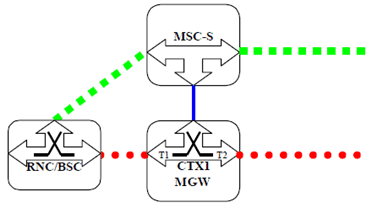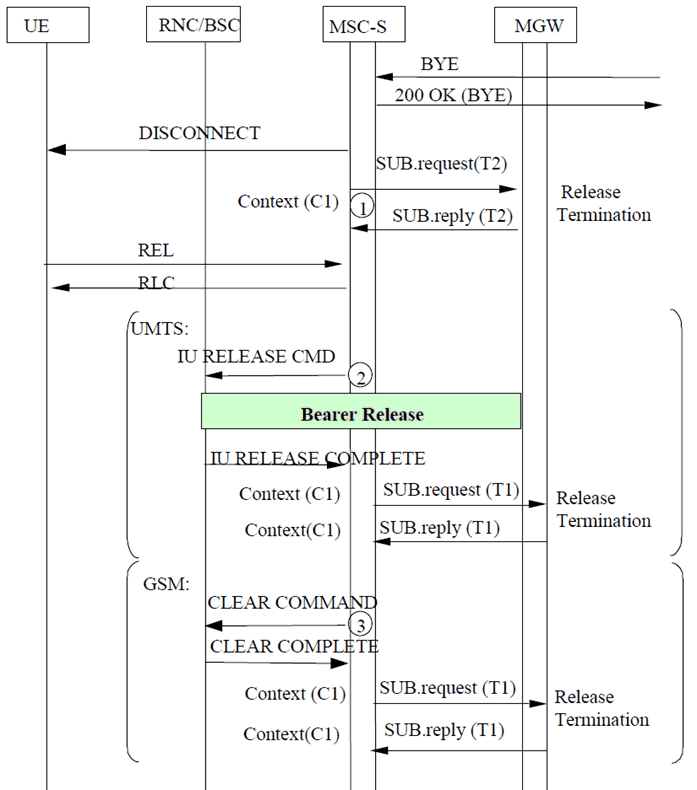Content for TS 23.231 Word version: 18.0.0
7 Call Clearing
7.1 General
7.2 Visited MSC Server Procedures
7.2.1 Call Clearing when Visited MSC Server has Forwarded/Deflected Call
7.2.2 Call Clearing received from core network
...
...
7 Call Clearing p. 33
7.1 General p. 33
The terms "incoming" and "outgoing" in the following text refers to the direction of propagation of the release indication, not to the direction of original call establishment.
During call establishment, the call may be released by sending a BYE or CANCEL request in the direction of the original call establishment, or by a failure response in the opposite direction of the original call establishment. For an established call, the call may be released by BYE request in the direction of the original call establishment or in the opposite direction of the original call establishment.
The term "release indication" in the following text refers to any message which is to release the call, i.e. it may be the BYE or CANCEL request, or the failure response to the initial INVITE request.
In accordance with ITU-T Q.1912.5 [9] Profile C, the generation of:
- a BYE request and a 4xx, 5xx, 6xx final response to initial INVITE should encapsulate an ISUP REL message.
- a 200 OK final response to a BYE request shall encapsulate an ISUP RLC message if a BYE is received with an encapsulated REL.
7.2 Visited MSC Server Procedures p. 34
7.2.1 Call Clearing when Visited MSC Server has Forwarded/Deflected Call p. 34
If the MSC server has forwarded/deflected the call to another terminating MSC server, call clearing is performed as described for the GMSC Server in clause 7.3.
7.2.2 Call Clearing received from core network p. 34
7.2.2.1 Procedures towards access side p. 34
The MSC server initiates call clearing towards the UE and requests release of the associated radio resources as described in TS 23.108. Once the call clearing and the release of the associated radio resources have been completed, the MSC server releases any MGW allocated resources for the access side. If any resources were seized in the MGW, the MSC server uses the Release Termination procedure to requests the MGW to remove the access side bearer termination.
7.2.2.2 Procedures towards network side p. 34
7.2.2.2.1 Call Clearing during establishment p. 34
7.2.2.2.1.1 Originating MSC-S p. 34
If the release indication from the succeeding node is a failure response for the initial INVITE request, the MSC server shall send an ACK for the failure response to the succeeding node.
The MSC server shall then perform the normal bearer release according to 7.2.6.
7.2.2.2.1.2 Terminating MSC-S p. 34
If a CANCEL request to initial INVITE is received from the preceding node, the MSC server shall send a 200 OK response for the CANCEL request and the MSC server shall immediately send a 487 Request Terminated response for the initial INVITE request to the preceding node.
If a BYE request is received from the preceding node, the MSC server shall send a 200 OK response for the BYE request, and immediately send a 487 Request Terminated response for the initial INVITE request to the preceding node.
The MSC sever shall then perform the normal bearer release according to clause 7.2.6.
7.2.2.2.2 Call Clearing after call established p. 34
7.2.2.2.2.1 Originating MSC-S p. 34
An MSC server that receives a BYE request from the succeeding node shall send a 200 OK response for the BYE request to the succeeding node. The MSC shall then perform the normal bearer release according to 7.2.6.
7.2.2.2.2.2 Terminating MSC-S p. 35
If an MSC server receives a CANCEL request from the preceding node it shall send a 200 OK(CANCEL) final response for the CANCEL request but shall not take further action.
If a BYE request is received from the preceding node, the MSC server shall send a 200 OK response for the BYE request to the preceding node. The MSC server shall then perform the normal bearer release according to clause 7.2.6.
7.2.2.3 Example Call Flow p. 35
Figure 7.2.2.3.1 shows the network model for a network initiated clearing of an established mobile call. The "squared" line represents the call control signalling. The "dotted" line represents the bearer control signalling (not applicable in A/Gb mode for the A-interface) and the bearer. The MSC server seizes one context with two bearer terminations in the MGW. Bearer termination T1 is used for the bearer towards RNC/BSC and bearer termination T2 is used for the bearer towards succeeding MGW.

Figure 7.2.2.3.2 shows the message sequence example for the network initiated clearing of an established mobile call. In the example when the call clearing indication is received from the preceding/succeeding node, the MSC server indicates to the preceding/succeeding node that call clearing has been completed and releases the network side bearer termination. The MSC server initiates call clearing towards the UE and requests release of the radio resource. After the response of the radio resource release is received then the MSC server requests release of the access side bearer termination.

Figure 7.2.2.3.2: Network Initiated Call Clearing (message sequence chart)
(⇒ copy of original 3GPP image)
(⇒ copy of original 3GPP image)